Using Similarity & Difference To Make Your Research Paper a Perfect Fit
There are so many scholarly authors producing excellent books and articles these days that academic and scientific publishers can pick and choose when it comes to filling the coveted space available in their books and journals. Maintaining the highest standards of scholarship within your field and discipline remains essential to success, but ensuring a perfect fit between your writing and the kind of work published by the journal or press to which you submit your article or book can be equally important. The principles of similarity and difference can be most helpful in establishing a perfect fit.
If you have a particular press or journal in mind before you conduct your research and write your text, you can certainly design both your investigation and your writing with the kind of work published by that press or journal in mind. Far more often, however, research is designed according to its own requirements and the text reporting it shaped in relation to that research. A publisher will need to be chosen, then, on the basis of its interest in publishing research of a kind similar to the research you are conducting. This initial similarity can then be enhanced by fine tuning your writing and presenting it in ways that will be particularly appealing to that publisher. Pointing out in your covering letter that your work is very similar to important books or articles previously produced by the publisher is an excellent strategy, as is citing and quoting those publications, but in a reasonable way. Do not add inappropriate citations – acquisitions editors with integrity and high standards will see right through them. Consulting the publisher’s guidelines, on the other hand, and formatting your writing to meet them are always sound strategies and should not be neglected if you are aiming for publication success.
While you are considering the ways in which your work is similar to work already published by the journal or press you have chosen it is essential not to neglect the differences between your research and the research presented in those earlier publications. Ask yourself how your research and writing builds in new and exciting ways on those publications. Focus on what is different about your topic, the methodology you use to explore it, the findings your methods produced, your analysis of those results, the conclusions you draw from them, the implications of your research and the recommendations you make. Point out the most important of these differences in your covering letter, and try to define precisely how your work picks up where the work previously published by the press or journal left off, follows recommendations in those earlier publications or fills a gap left by their approaches and conclusions. This will demonstrate how your work advances and increases the publisher’s overall contribution to knowledge in the area. When implemented effectively, such a strategy can make your writing appear in the eyes of an editor to be a natural stage in a publisher’s activities – a text that must be published and quickly before some other publisher has the chance to benefit from it.
Focussing on similarity and difference in these ways as you tailor your writing to fit a publisher can strike a balance between the continuity and innovation that lie at the heart of most accomplished research. Such a focus therefore often proves palatable to editors and appealing to a wide range of scholarly readers.
You might be interested in Services offered by Proof-Reading-Service.com
Journal Editing
Journal article editing services
PhD Thesis Editing
PhD thesis editing services
Expert Editing
Expert editing for all papers
Medical Editing
Medical Editing Services
Research Editing
Research paper editing services
Book Editing
Professional book editing services

















